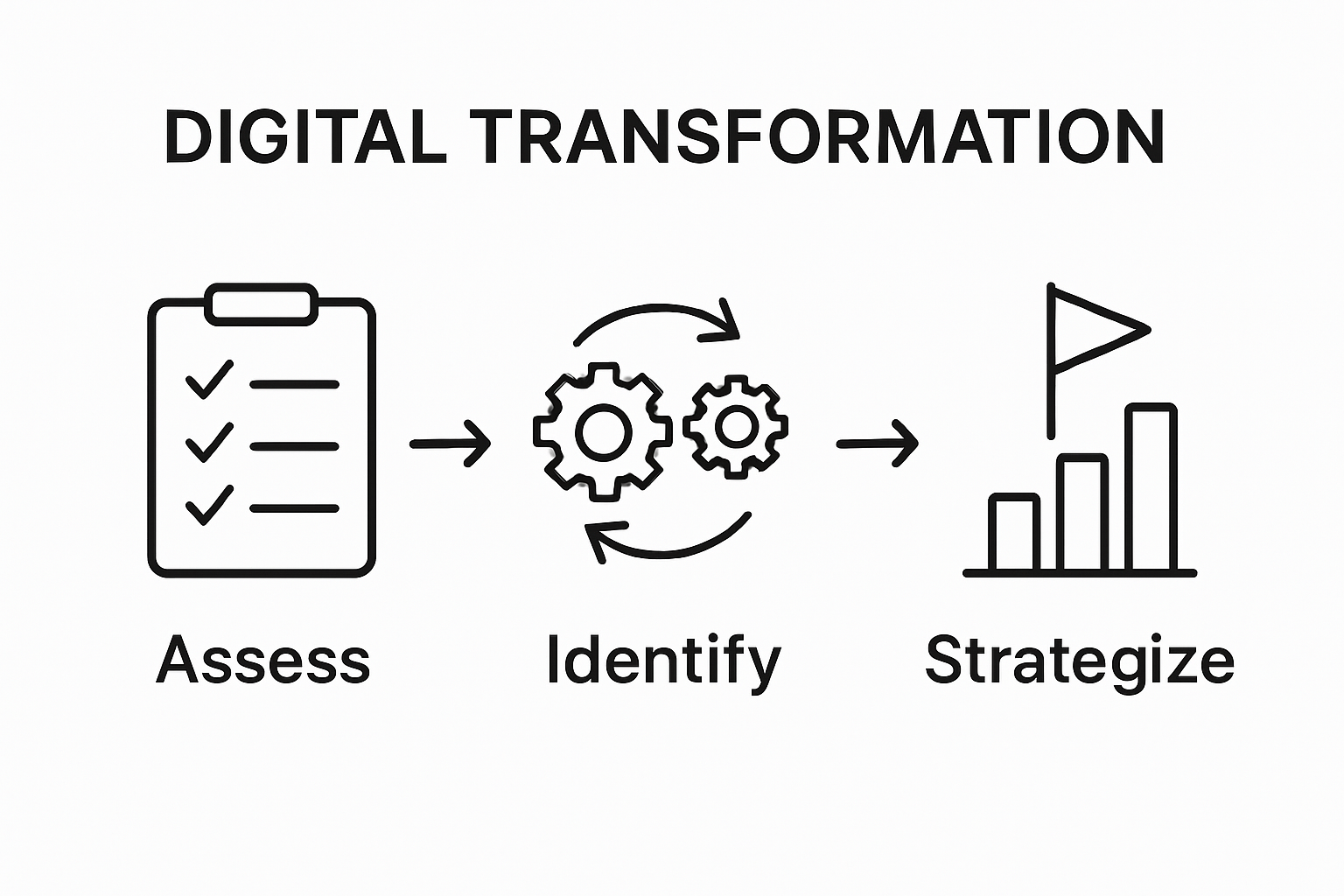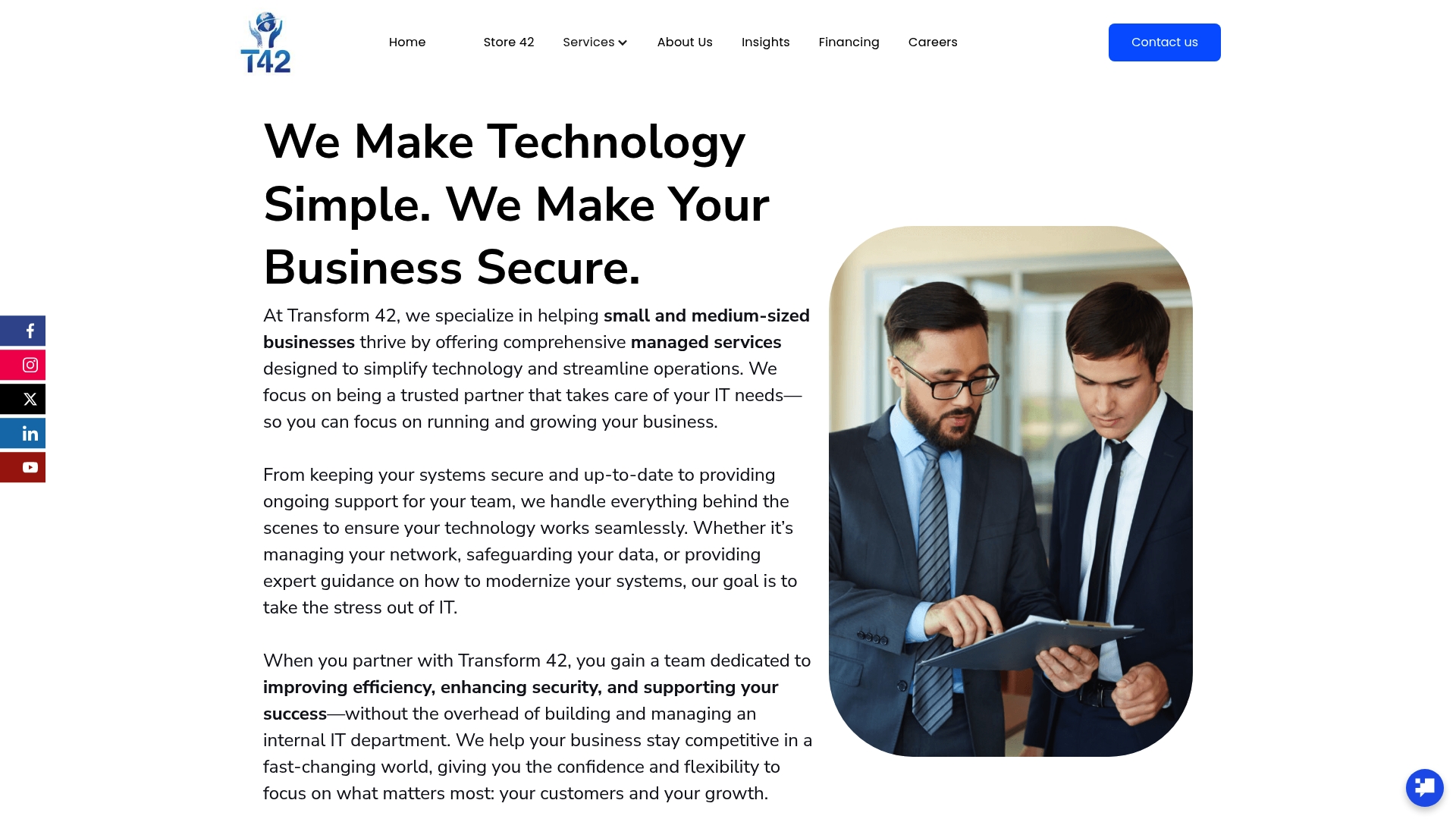
Digital transformation sounds like something only big corporations can afford, but over 75% of small businesses are now adopting digital tools to keep up. Most owners think the hardest part is choosing the right technology. The real challenge is in getting your team on board and making each step work for your unique business, not just installing the latest software.
Key PointExplanation1. Conduct a digital capabilities assessmentEvaluate your current technologies and processes to identify strengths, weaknesses, and opportunities for improvement.2. Identify specific areas for digital improvementAnalyze business functions to find key areas where digital tools can enhance efficiency and customer engagement.3. Develop a clear digital transformation strategyCreate a strategic roadmap that outlines measurable goals and aligns technological investments with business objectives.4. Implement technologies carefullySelect and integrate tools gradually, prioritizing those that address immediate challenges while ensuring user-friendly interfaces.5. Train your team continuouslyProvide comprehensive, practical training for employees to adapt to new technologies, fostering a supportive learning culture.
Digital transformation begins with a clear understanding of your current technological landscape. This crucial first step helps small businesses identify strengths, weaknesses, and opportunities for digital integration across their entire organization. By conducting a comprehensive digital capabilities assessment, you create a strategic roadmap that guides your transformation journey.
To start your assessment, gather a cross-functional team that represents different departments and perspectives within your business. This might include your IT manager, sales lead, operations coordinator, and a few key team members who interact daily with your existing systems. Their collective insights will provide a holistic view of your current digital infrastructure and workflows.
Begin by mapping out your existing digital tools and technologies. Create a detailed inventory that includes all current software, hardware, communication platforms, and digital systems your business uses. Pay special attention to areas like customer relationship management, financial tracking, communication tools, and operational software. Document not just the tools themselves, but how frequently they are used, their integration capabilities, and any pain points your team experiences.
According to the OECD Digital Transformation Report, successful digital assessments go beyond technology and include evaluating digital skills and readiness within your organization. Conduct an honest skills audit by asking team members about their comfort level with current technologies and identifying potential training needs. This human element is often overlooked but critical for successful digital transformation.
Verify your assessment’s completeness by checking for these key indicators:
Below is a checklist summarizing key verification steps to ensure your digital capabilities assessment is comprehensive and actionable.
Assessment Checklist ItemDescriptionInventory of Digital Tools and PlatformsDocument all current software, hardware, and systems in useUnderstanding of Technological LimitationsIdentify areas where technology is lacking or outdatedSkill Gaps IdentifiedAssess employee comfort with tech and note required trainingWorkflow Inefficiencies DocumentedRecord areas where processes are slow or problematicList of Potential Technological ImprovementsNote initial ideas for tech-based enhancements
Remember, this assessment is not about criticizing current systems but creating a foundation for strategic improvement. Approach the process with curiosity and an open mind, viewing it as an opportunity to unlock your business’s digital potential.
After completing your initial digital capabilities assessment, the next critical step is identifying specific areas where digital transformation can drive meaningful business improvements. This process requires a strategic approach that balances current operational needs with future growth potential. By systematically evaluating your business functions, you can pinpoint precise opportunities for digital enhancement.
Start by analyzing each core business function through a digital optimization lens. Customer interactions, operational workflows, data management, and communication systems represent prime areas for potential transformation. Consider how digital tools could streamline processes, reduce manual work, and create more efficient pathways for delivering value to your customers. Look for recurring bottlenecks, time-consuming manual tasks, and areas where information flow is currently fragmented or slow.
According to the OECD Digital Transformation Report, small businesses often benefit most by prioritizing digital improvements in these key domains:
Critical to this process is involving your team in identifying improvement areas. Schedule collaborative sessions where employees can share their insights about daily operational challenges. The people closest to your workflows often have the most nuanced understanding of where digital solutions could make the greatest impact. Encourage open, judgment-free discussions that surface both frustrations and potential technology-driven solutions.
Verify your improvement identification process by ensuring you have developed a clear, prioritized list of digital enhancement opportunities. This list should include specific pain points, potential technological solutions, estimated implementation complexity, and potential return on investment. Your goal is not to implement everything at once, but to create a strategic roadmap that allows for phased, manageable digital transformation. By taking a methodical approach, you transform digital improvement from an overwhelming challenge into an achievable, step-by-step journey.

Developing a comprehensive digital transformation strategy transforms your initial assessment and improvement insights into a concrete action plan. This strategic roadmap will guide your business through the complex process of technological integration, ensuring that digital investments align with your broader business objectives and deliver tangible value.
Begin by translating your identified improvement areas into specific, measurable goals. These objectives should be clear, realistic, and tied directly to your business outcomes. For instance, instead of a vague goal like “improve digital capabilities,” articulate a precise target such as “reduce customer service response time by 40% through implementing an integrated communication platform” or “increase online sales by 25% by enhancing our e-commerce website’s user experience.”
According to the OECD Digital Transformation Report, successful digital strategies require a holistic approach that considers technological, human, and organizational dimensions. Create a comprehensive strategy document that outlines not just technological investments, but also addresses critical supporting elements like staff training, change management processes, and potential cultural shifts required to support digital transformation.
Your strategy should include a detailed implementation roadmap with clear timelines, resource allocations, and milestone tracking.
This table provides an overview of core elements to include in your digital transformation strategy for clear execution and measurable results.
Strategy ComponentPurposePrioritized Digital InitiativesFocus on projects with the greatest business impactBudget and Resource EstimatesIdentify costs and team involvement needed for each stepTechnology and Tools SelectionChoose solutions that fit business needs and allow for growthStaff Training RequirementsPlan for skill development to support new systemsKey Performance IndicatorsDefine how you will measure progress and success
Break down your digital transformation into manageable phases, allowing for incremental progress and periodic reassessment. This approach minimizes risks and provides flexibility to adjust your strategy as you learn and grow.
Consider these critical components when developing your strategy:
Verify your strategy’s completeness by ensuring it provides a clear, actionable blueprint that connects your current capabilities with your desired digital future. A well-crafted strategy serves as a living document that can be regularly reviewed and updated, transforming digital transformation from a one-time project into an ongoing journey of continuous improvement and innovation.
Implementing the right technologies and tools marks a critical transition point in your digital transformation journey. This step transforms your strategic planning into tangible technological solutions that will reshape how your business operates, communicates, and delivers value to customers. Successful implementation requires a careful, deliberate approach that balances technological capabilities with your organization’s unique needs and constraints.
Begin by selecting technologies that directly address the improvement areas identified in your earlier assessments. Prioritize tools that offer seamless integration, scalability, and user-friendly interfaces. Look for solutions that not only solve immediate challenges but also provide flexibility for future growth. Consider cloud-based platforms that allow for modular expansion and offer robust support for small businesses with limited IT resources.
According to the OECD’s Digital for SMEs Initiative, successful technology implementation involves more than just purchasing software. Create a comprehensive implementation plan that includes detailed timelines, staff training schedules, and clear protocols for transitioning from existing systems. This approach minimizes disruption and ensures your team feels supported throughout the technological transformation.
Approach implementation as a phased process, starting with the most critical and least disruptive technologies. Pilot new tools with a small team or specific department before full-scale rollout. This strategy allows you to identify potential challenges, gather user feedback, and make necessary adjustments without risking entire organizational operations. Encourage open communication and provide multiple channels for team members to share their experiences and concerns during the implementation process.
Consider these essential considerations during technology implementation:
Verify the success of your implementation by establishing clear performance metrics and conducting regular check-ins with your team. Look for tangible improvements in efficiency, communication, and overall business performance. Remember that digital transformation is an ongoing journey. Remain flexible, continuously gather feedback, and be prepared to adapt your technological approach as your business evolves and new innovations emerge.
Training your team on new digital practices is the critical bridge between technological implementation and actual business transformation. This step ensures that your technological investments translate into genuine operational improvements, empowering your employees to leverage new tools effectively and confidently. Successful digital skills training goes beyond simple technical instruction, focusing on building a culture of continuous learning and technological adaptability.
Begin by conducting a comprehensive skills assessment that identifies current digital competencies and potential knowledge gaps across your organization. Create personalized learning pathways that recognize individual team members’ existing skills and learning preferences. Some employees might require foundational digital literacy training, while others may need advanced technical workshops specific to new tools and platforms your business has implemented.
According to the OECD Digital Transformation Report, effective digital skills training should be interactive, practical, and closely aligned with actual work processes. Design training programs that combine formal instruction with hands-on practice, allowing employees to immediately apply new skills in their daily workflows. Consider a mix of training methods, including online courses, in-person workshops, peer-learning sessions, and one-on-one coaching to accommodate different learning styles.
Psychological support is equally important during digital skills training. Recognize that technological change can create anxiety and resistance among team members. Foster an organizational culture that views digital learning as an opportunity for personal and professional growth, not a threat. Encourage open dialogue about challenges, celebrate small victories, and create safe spaces for employees to ask questions and express concerns during the transition.
Consider these key elements in your team training approach:
Verify the effectiveness of your training by establishing clear performance metrics, conducting periodic skills assessments, and gathering feedback from team members. Look for improvements in technological confidence, workflow efficiency, and overall team engagement with new digital practices. Remember that digital skills training is an ongoing process, requiring continuous investment and adaptation as technology evolves.

Monitoring progress and making strategic adjustments is the critical final step that transforms digital transformation from a one-time project into a continuous improvement process. This stage ensures that your technological investments deliver tangible business value and remain aligned with your evolving organizational goals. Successful monitoring goes beyond simple performance tracking, requiring a holistic approach that considers technological, operational, and human factors.
Establish a comprehensive performance measurement framework that captures both quantitative and qualitative metrics across different aspects of your digital transformation. Develop key performance indicators (KPIs) that reflect specific objectives identified in your original strategy. These might include metrics like operational efficiency improvements, customer engagement rates, employee digital skill progression, and direct financial impacts such as cost savings or revenue increases.
According to the OECD Digital Transformation Report, effective monitoring requires regular and structured assessment. Schedule quarterly review sessions where your leadership team critically evaluates digital transformation progress. During these sessions, analyze performance data, gather feedback from team members, and identify potential areas for refinement. Create a culture of transparent, constructive dialogue that views technological adjustments as opportunities for growth rather than indicators of initial failure.
Implement a flexible adjustment mechanism that allows for incremental changes. Not every technological solution will work perfectly from the start, and your ability to pivot quickly can significantly impact overall digital transformation success. This might involve recalibrating training programs, modifying technological tools, or reallocating resources based on emerging insights. Stay open to experimenting and learning, recognizing that digital transformation is an ongoing journey of continuous adaptation.
Consider these critical monitoring elements:
Verify the effectiveness of your monitoring process by ensuring you have a clear, documented approach to tracking progress, making decisions, and implementing changes. A successful monitoring strategy transforms digital transformation from a static plan into a dynamic, responsive approach that keeps your business technologically competitive and operationally agile.
You have just learned about the importance of step-by-step digital transformation for small businesses. The article highlighted common challenges like unclear technology strategy, skills gaps, disjointed workflows, and the fear of disruption when choosing new tools. Many businesses struggle to translate assessments and plans into impactful changes that last.

At Transform 42 Inc., we specialize in guiding small and mid-sized companies from initial digital assessments all the way to measurable business improvements. Our team does more than advise — we roll up our sleeves to help you prioritize digital investments, address workflow inefficiencies, and build a continuous improvement culture. If you are ready to see real progress and want an expert partner to support your entire journey, explore our digital transformation solutions today. Do not wait to make your organization more agile and competitive. Visit Transform 42 Inc. to request a tailored consultation that gets you results, not just reports.
Digital transformation begins with assessing your current digital capabilities. This involves understanding your technological landscape, identifying strengths and weaknesses, and mapping out existing digital tools and systems.
Start by analyzing core business functions like customer interactions, operational workflows, and data management. Look for bottlenecks, manual tasks, and fragmented information flows to pinpoint specific opportunities for digital enhancement.
A digital transformation strategy should include specific, measurable goals related to your improvement areas, a detailed implementation roadmap, resource requirements, and key performance indicators to measure success.
Conduct a skills assessment to identify knowledge gaps, then create customized training programs that combine formal instruction with hands-on practice. Encourage a culture of continuous learning and support throughout the training process.